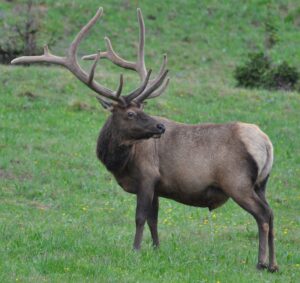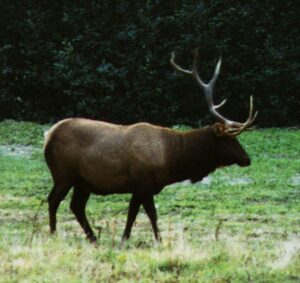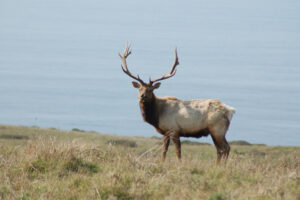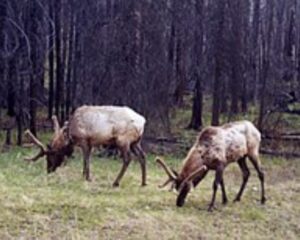 Types of Elk
Types of Elk
Types of Elk
In the United States, there are four subspecies of elk recognized:

- Rocky Mountain Elk (Cervus canadensis nelsoni): The Rocky Mountain Elk is the most widespread subspecies and is found in various western states. Its range includes Colorado, Idaho, Montana, Oregon, Utah, Washington, Wyoming, and parts of British Columbia, Alberta, and Saskatchewan in Canada.
- Roosevelt Elk (Cervus canadensis roosevelti): Roosevelt Elk is found primarily along the Pacific Coast in the states of California, Oregon, and Washington. They inhabit the coastal forests and are named after President Theodore Roosevelt.
- Tule Elk (Cervus canadensis nannodes): The Tule Elk is native to California and is found in the Central Valley and surrounding areas. Their population was once critically low, but conservation efforts have helped increase their numbers.
- Manitoban Elk (Cervus canadensis manitobensis): Manitoban Elk, also known as Eastern Elk, was historically found in parts of the Midwest and Eastern regions of the United States. However, they were extirpated from these areas and are now primarily found in Manitoba, Canada.
Each subspecies has distinct characteristics that set them apart:
Rocky Mountain Elk: This subspecies is known for its large body size, impressive antler development, and varied coat colors. They are adaptable to a range of habitats and are highly sought after by hunters.
Roosevelt Elk: Roosevelt Elk are the largest subspecies of elk in North America. They have darker coats, long antlers, and are well-adapted to the dense forests along the Pacific Coast.
Tule Elk: Tule Elk are the smallest subspecies of elk, adapted to the grasslands and marshes of California. They have a light coat color and compact antlers.
Manitoban Elk: This subspecies, now primarily found in Canada, had historically roamed the Midwest and Eastern United States. They were larger than the other subspecies, with significant antler size and body mass.
As for specific population numbers and distributions in each state, it’s important to note that elk populations can fluctuate due to various factors, including hunting, habitat changes, and conservation efforts. It’s recommended to refer to recent wildlife management reports, state agencies, or organizations dedicated to elk conservation for the most accurate and up-to-date information on elk populations in each state. Best States for Hunting Elk
Each Type of Elk in the United States Major Characteristics
Rocky Mountain Elk
The Rocky Mountain Elk: Majesty of the Western Wilderness

Rocky Mountain Elk https://www.flickr.com/photos/50764314@N04
Introduction: The Rocky Mountain Elk (Cervus canadensis nelsoni) is an iconic and majestic species that roams the vast expanses of the western United States and parts of Canada. With its impressive antlers, regal stature, and captivating presence, the Rocky Mountain Elk has captured the hearts and imaginations of wildlife enthusiasts, photographers, and hunters alike. In this article, we will explore the habitat, diet, and mating season of the Rocky Mountain Elk, shedding light on the captivating aspects of this remarkable creature.
Habitat and Range: As the name suggests, the Rocky Mountain Elk primarily inhabits the Rocky Mountain region of North America. Their range extends across several western states, including Colorado, Idaho, Montana, Oregon, Utah, Washington, Wyoming, and parts of British Columbia, Alberta, and Saskatchewan in Canada. These vast and diverse landscapes provide an ideal environment for elk, with rugged mountains, expansive forests, and wide-open grasslands offering ample opportunities for foraging, shelter, and survival.
Diet and Foraging Habits: The Rocky Mountain Elk is a herbivorous species with a varied and adaptable diet. Their primary food sources consist of grasses, forbs, shrubs, and browse vegetation. During the summer months, elk graze on abundant grasses and forbs found in open meadows and alpine areas. As the seasons change and food availability shifts, they also browse on shrubs, tree bark, and twigs. Elk have a unique ability to extract nutrients from nutrient-poor forage, allowing them to thrive in diverse habitats.
Mating Season and Rut: The mating season, also known as the rut, is a fascinating and crucial time in the life of Rocky Mountain Elk. It typically occurs during the fall months, with specific timing varying depending on the region and environmental factors. The rut is characterized by intense social interactions, vocalizations, and displays of strength among the males, as they compete for the attention and mating rights with females.
During the rut, bull elk undergo remarkable physical transformations. They develop a thicker neck and shoulder muscles, which enhance their ability to fight and defend their harem of females. One of the most iconic features of the Rocky Mountain Elk is the bull’s antlers, which reach their peak size and complexity during this time. These antlers are used both as weapons in battles for dominance and as visual displays to attract mates.
The vocalizations of elk during the rut are also striking. Bulls emit a resonant bugling call that carries through the mountain valleys, serving as a declaration of their dominance and a signal to competing males. Bugles can vary in pitch and intensity, conveying information about a bull’s size, strength, and reproductive fitness. This vocal symphony adds a captivating layer to the wild landscapes where elk reside.
The competition for mating rights can be intense, with rival bulls engaging in elaborate displays of dominance. They clash antlers, lock horns, and engage in physical confrontations to establish their hierarchy and secure access to receptive females. These battles can be fierce, with the clashing of antlers echoing through the wilderness. The victors of these battles earn the privilege of mating with a group of females, known as a harem.
Once a bull successfully establishes dominance, he actively seeks out receptive females, or cows, within his harem. The cows play a critical role in the mating process as well. They communicate their reproductive readiness through a series of behaviors and pheromone signals. A cow will choose a dominant bull based on his strength, size, and display of fitness.
The Rocky Mountain Elk mating season is not only a spectacle of natural beauty but also a crucial event for the species’ reproductive success. The genetic diversity and health of the population depend upon successful conditions for mating.
Roosevelt Elk
The Roosevelt Elk: Majesty of the Pacific Coast

Roosevelt Elk
https://www.flickr.com/photos/39108150@N05
Introduction: The Roosevelt Elk (Cervus canadensis roosevelti) is a magnificent and awe-inspiring creature that roams the coastal regions of the Pacific Northwest. Known for its large size, majestic antlers, and affinity for dense forests, the Roosevelt Elk captivates the hearts and imaginations of nature enthusiasts, photographers, and wildlife lovers. In this article, we will delve into the habitat, diet, and mating season of the Roosevelt Elk, unraveling the captivating aspects of this remarkable subspecies.
Habitat and Range: The Roosevelt Elk primarily inhabits the coastal regions of California, Oregon, and Washington, where it thrives in the diverse ecosystems along the Pacific Coast. These areas are characterized by dense forests, rugged terrain, and ample water sources, creating an ideal habitat for the elk. The Roosevelt Elk’s range spans from the coastal lowlands to the subalpine regions of the coastal mountain ranges, allowing them to explore a variety of habitats within their territory.
Diet and Foraging Habits: Roosevelt Elk are herbivorous animals with a diverse and adaptable diet. They consume a wide range of vegetation, including grasses, forbs, shrubs, ferns, and tree bark. Their ability to browse on various plant species enables them to find sustenance in the dense forests they call home. During the summer months, when meadows and open areas are abundant, they graze on grasses and forbs. As the seasons change and food availability fluctuates, they shift to browsing on woody vegetation, including shrubs and tree branches.
Mating Season and Rut: The mating season, also known as the rut, is a significant period in the life of Roosevelt Elk. It typically occurs during the fall months, usually between September and October. The timing of the rut can vary depending on environmental factors, such as food availability and weather conditions, as well as the individual’s age and condition.
During the rut, male Roosevelt Elk, known as bulls, engage in intense competitions for mating rights with females, or cows. This is a time of heightened activity, vocalizations, and displays of strength and dominance. Bulls undergo remarkable physical changes, such as developing a thicker neck and shoulder muscles, which enhance their ability to fight and establish dominance.
One of the most captivating aspects of the Roosevelt Elk rut is the bulls’ majestic antlers. These antlers can reach impressive sizes, with multiple points and immense spans, serving as visual displays and weapons during battles for dominance. The size and complexity of antlers are key factors in determining a bull’s rank within the hierarchy and attracting mates.
Vocalizations play a vital role in the rutting behavior of Roosevelt Elk. Bulls emit a resonant bugling call that reverberates through the dense forests and valleys. Bugling serves as a way for bulls to establish their presence, communicate with females, and challenge rival males. The bugle is a haunting and powerful sound that adds a captivating element to the coastal landscapes where Roosevelt Elk reside.
During the rut, bulls engage in physical confrontations to assert dominance and win mating rights. These battles can be intense, with clashing antlers and displays of strength. The fights are not only determined by physical attributes but also by behavioral cues and intimidation tactics. The victorious bull earns the privilege of mating with a group of receptive females.
Within the hierarchy established during the rut, bulls maintain a harem of cows. The cows play an essential role in the mating process as well. They communicate their receptivity through behavior and scent cues, indicating their readiness to mate. The dominant bulls, with their size, strength, and display of fitness, attract the attention and preference of the cows.
The mating season of Roosevelt Elk is a remarkable natural spectacle
The Tule Elk: Resilience of California’s Grasslands

Tule Elk
https://www.flickr.com/photos/48372717@N00
Introduction: The Tule Elk (Cervus canadensis nannodes) is a remarkable subspecies of elk that holds a significant place in California’s natural heritage. Named after the tule marshes where they were first discovered, the Tule Elk represents a story of conservation success and the resilience of a species on the brink of extinction. In this article, we will explore the habitat, diet, and mating season of the Tule Elk, shedding light on the captivating aspects of this unique subspecies.
Habitat and Range: The Tule Elk primarily inhabits the grasslands and marshes of California’s Central Valley and surrounding areas. Historically, they occupied a range extending from the Sierra Nevada foothills to the Pacific Coast. However, due to habitat loss and overhunting, their population drastically declined in the late 19th century. Thanks to conservation efforts, including the establishment of protected areas and reintroduction programs, the Tule Elk has made a remarkable recovery and can now be found in several locations within their historic range.
Diet and Foraging Habits: Tule Elk are herbivorous animals with a diet that consists mainly of grasses, forbs, and browse vegetation. They are well-adapted to the grasslands and marshes they inhabit, utilizing the diverse plant species found in these ecosystems. During the summer months, when the grasses are abundant, Tule Elk graze on a variety of grass species, utilizing their specialized molars to efficiently consume and process their food. As the seasons change and grass availability decreases, they also browse on shrubs, tree bark, and twigs to meet their nutritional needs.
Mating Season and Rut: The mating season, also known as the rut, is a significant event in the life of Tule Elk. It typically occurs during the late summer and early fall months, usually between August and October. The timing of the rut can vary depending on environmental factors, such as temperature, rainfall, and the availability of food resources.
During the rut, male Tule Elk, known as bulls, engage in intense competition for mating rights with females, known as cows. This period is characterized by behavioral displays, vocalizations, and physical interactions among the bulls. Bulls undergo remarkable physiological changes during this time, including an increase in testosterone levels, which contribute to their aggressive behavior and physical transformations.
One of the striking features of the Tule Elk rut is the vocalizations produced by the bulls. They emit a series of bugles and bellows that resonate through the grasslands, serving as a means of communication and asserting their dominance. The bugling calls can vary in pitch, intensity, and duration, conveying information about a bull’s size, strength, and reproductive fitness. These vocal displays add a captivating element to the Tule Elk’s mating rituals.
Physical confrontations and displays of strength are common during the rut, as bulls compete for access to receptive females. They engage in clashes, locking antlers and pushing against each other to establish dominance. The size and configuration of their antlers play a significant role in determining their success in these confrontations. The dominant bull, with its impressive antlers and display of strength, earns the privilege of mating with a group of cows.
Cows also play an important role in the mating process. They exhibit specific behaviors and cues to indicate their receptiveness to mating. Cows may emit estrous calls and display submissive behavior, signaling their readiness to mate. The dominant bulls actively seek out and guard receptive cows, forming temporary breeding groups or harems during the rut.
The mating season of Tule Elk is a captivating spectacle that showcases the perseverance and resilience of this subspecies. The successful reproduction and survival of new generations are vital for the long-term conservation of the Tule Elk population and the preservation of their unique genetic lineage.
Conclusion: The Tule Elk’s habitat, diet, and mating season are intricately connected to their survival and conservation. As they continue to thrive in California’s grasslands and marshes, these magnificent creatures serve as a symbol of resilience and the successful restoration of a once-endangered species. Through ongoing efforts in habitat conservation and management, the Tule Elk’s future remains promising, ensuring that future generations can witness the grandeur of these remarkable animals in the wild.
The Manitoban Elk: Majesty of the Prairie

Manitoba Elk
Introduction: The Manitoban Elk, also known as the Eastern Elk or Elk Island Elk (Cervus canadensis canadensis), is a magnificent subspecies of elk that roams the expansive prairies and forests of Manitoba, Canada. With its majestic antlers, regal stature, and captivating presence, the Manitoban Elk captures the imagination of wildlife enthusiasts, photographers, and nature lovers. In this article, we will delve into the habitat, diet, and mating season of the Manitoban Elk, shedding light on the captivating aspects of this remarkable subspecies.
Habitat and Range: The Manitoban Elk is primarily found in the prairies, boreal forests, and parklands of Manitoba, Canada. This vast and diverse landscape provides an ideal habitat for the elk, with a combination of open grasslands, dense forests, and meandering rivers. The Elk Island National Park in Alberta also serves as a significant conservation area for the Manitoban Elk, allowing for the protection and preservation of their population.
Diet and Foraging Habits: The Manitoban Elk is a herbivorous species with a varied and adaptable diet. Their primary food sources consist of grasses, forbs, shrubs, and browse vegetation. During the summer months, when meadows and grasslands are abundant, the elk graze on a variety of grass species, utilizing their strong molars to efficiently consume and process their food. As the seasons change and food availability shifts, they also browse on shrubs, tree bark, and twigs to meet their nutritional needs.
Mating Season and Rut: The mating season, also known as the rut, is a significant period in the life of the Manitoban Elk. It typically occurs during the fall months, usually between September and October. The timing of the rut can vary depending on environmental factors, such as temperature, rainfall, and the availability of food resources.
During the rut, male Manitoban Elk, known as bulls, engage in intense competition for mating rights with females, known as cows. This period is characterized by behavioral displays, vocalizations, and physical interactions among the bulls. Bulls undergo remarkable physiological changes during this time, including an increase in testosterone levels, which contribute to their aggressive behavior and physical transformations.
One of the most fascinating aspects of the Manitoban Elk rut is the vocalizations produced by the bulls. They emit a series of bugles, grunts, and bellows that resonate through the prairies and forests, serving as a means of communication and asserting their dominance. The bugling calls can vary in pitch, intensity, and duration, conveying information about a bull’s size, strength, and reproductive fitness. These vocal displays add a captivating element to the Manitoban Elk’s mating rituals.
Physical confrontations and displays of strength are common during the rut, as bulls compete for access to receptive females. They engage in clashes, locking antlers and pushing against each other to establish dominance. The size and configuration of their antlers play a significant role in determining their success in these confrontations. The dominant bull, with its impressive antlers and display of strength, earns the privilege of mating with a group of cows.
Cows also play an important role in the mating process. They exhibit specific behaviors and cues to indicate their receptiveness to mating. Cows may emit estrous calls and display submissive behavior, signaling their readiness to mate. The dominant bulls actively seek out and guard receptive cows, forming temporary breeding groups or harems during the rut.
The mating season of the Manitoban Elk is a captivating spectacle that showcases the power, resilience, and beauty of this subspecies. It is a crucial event for the continuation of their lineage and the preservation
Different physical characteristics between the four types of elk found in the United States
Certainly! Here are the different physical characteristics between the four types of elk found in the United States:
-
Rocky Mountain Elk (Cervus canadensis nelsoni):
- Size: Rocky Mountain Elk are one of the larger subspecies of elk.
- Body Color: They have a light to dark brown body coloration, often with a reddish hue.
- Antler Size: Bulls have impressive antlers that can reach large sizes, with multiple points and sweeping branches.
- Rump Patch: They have a distinct white rump patch, which is a patch of white hair located above the tail.
- Bugle: Their bugling vocalization is distinctive and resonant.
-
Roosevelt Elk (Cervus canadensis roosevelti):
- Size: Roosevelt Elk are the largest subspecies of elk.
- Body Color: They have a dark brown or blackish coat, often darker than other elk subspecies.
- Antler Size: Bulls possess large and massive antlers, with a distinctive shape and configuration.
- Mane: They have a prominent and thick neck mane, which extends down the chest and shoulders.
- Bugle: Their bugling vocalization is deep and powerful.
-
Tule Elk (Cervus canadensis nannodes):
- Size: Tule Elk are relatively smaller compared to other subspecies.
- Body Color: They have a light to dark brown body coloration, often with a grayish hue.
- Antler Size: Bulls have relatively smaller antlers with a more compact shape and fewer points.
- Tule Islands: They are known for their unique adaptation to the Tule Elk State Reserve on the Tule Islands in California.
- Bugle: Their bugling vocalization is high-pitched and distinctive.
-
Manitoban Elk (Cervus canadensis canadensis):
- Size: Manitoban Elk are medium to large in size, similar to Rocky Mountain Elk.
- Body Color: They have a light to dark brown body coloration, often with a reddish hue.
- Antler Size: Bulls possess impressive antlers with multiple points and sweeping branches, similar to Rocky Mountain Elk.
- Range: They primarily inhabit the grasslands and forests of Manitoba, Canada.
- Bugle: Their bugling vocalization is similar to Rocky Mountain Elk, with a distinctive resonant sound.
These physical characteristics help distinguish each elk subspecies and contribute to their unique appearance and adaptability to their respective habitats.
Leave a Reply